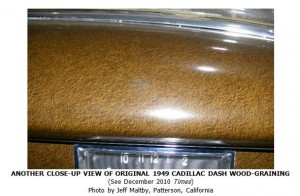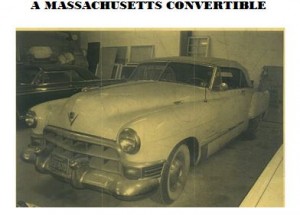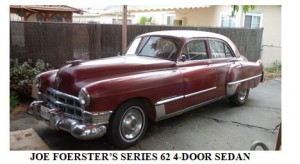Lately, I’ve been hearing more stories about ’49 Cads experiencing vapor lock. This ailment is due to engine heat causing gasoline to boil away or vaporize at certain spots in the fuel line. This makes for air in the fuel line, starving your engine of fuel, which will then stall or refuse to start. As ’49 Cadillacs were not known for having this problem in the past, it makes me wonder if it is not some new problem with the formulation of gasoline. The following may help and if any members have additional suggestions, please send them to the Times:
1. Check to see if air is freely flowing through the radiator and that the motor is running at a normal temperature;
2. Check your steel fuel line make sure it is not passing to close to the driver’s side exhaust manifold and check the flexible fuel line from the end of the steel line into the fuel pump to make sure it is not touching or passing very close to the oil filler housing or another hot part of the motor;
One possible solution is to wrap an insulating material around the rubber fuel line between the end of the steel line and the fuel pump. You can also do the same for the steel line between the pump and the carburetor. A good insulator is a length of rubber fuel line or, alternatively, insulated hose used for radiator return lines. It should be of the right diameter; that is, of course, bigger than the line to be wrapped. Cut it longitudinally (along its length) and place it around the length of the fuel line to be insulated. It’s expensive (at $4 / foot here in GA), but if it solves the problem is money well spent. Another insulation material is aluminum foil. I’m not sure about other alternatives to cover the fuel lines, but you can try McVey’s for some insulating material, as they do sell stuff of this type for exhaust pipes, or go to a hardware store and see what they suggest.
Another solution is to install an electric fuel pump. If you do so, I would not do away with the mechanical pump, but merely have the electric pump as an auxiliary. I have such a set up on 2 of my cars (but not my ’49 Cad which does not vapor lock yet). Install it so that the electric pump on a separate small fuel circuit with 2 “T” connections near the fuel tank and not merely in line with the mechanical pump. A more ambitious electric fuel pump installation involves installing a “T” connection just outside the fuel tank, with one branch of the “T” connection serving the existing steel fuel line and the mechanical pump. From the 2nd branch of this “T” connection near the fuel tank, install a short line to the electric pump. From the outlet of the electric pump install a second long steel fuel line, parallel to the long steel existing line, all the way to a rubber line going into a second “T” connection near the carburetor, thereby bypassing the mechanical pump altogether. This second set-up will look funny but will probably work well. The mechanical pump puts out 4 to 5¼ lbs, so the electric pump should not put out more than this.
If you suspect your engine temperature is too hot, a good way to accurately check it is to temporarily hook up a mechanical temp gauge to the same point on the rear of the passenger’s side cylinder head as the stock electrical sending unit. You can buy one and any necessary screw-in adapter inexpensively at an auto parts store. You install it by temporarily removing the passenger’s side ventilating tube, run the cable through the hole and gently close the vent valve over the cable to prevent most hot air entering the engine compartment. I’ve done this with my own car and have been surprised at the difference in readings between the stock electrical and auxiliary mechanical temperature gauge readings.
On the other hand, the motor’s symptoms may be due to something else altogether, a constricted fuel line. See John Washburn’s article in the May 2011 Self Starter.



